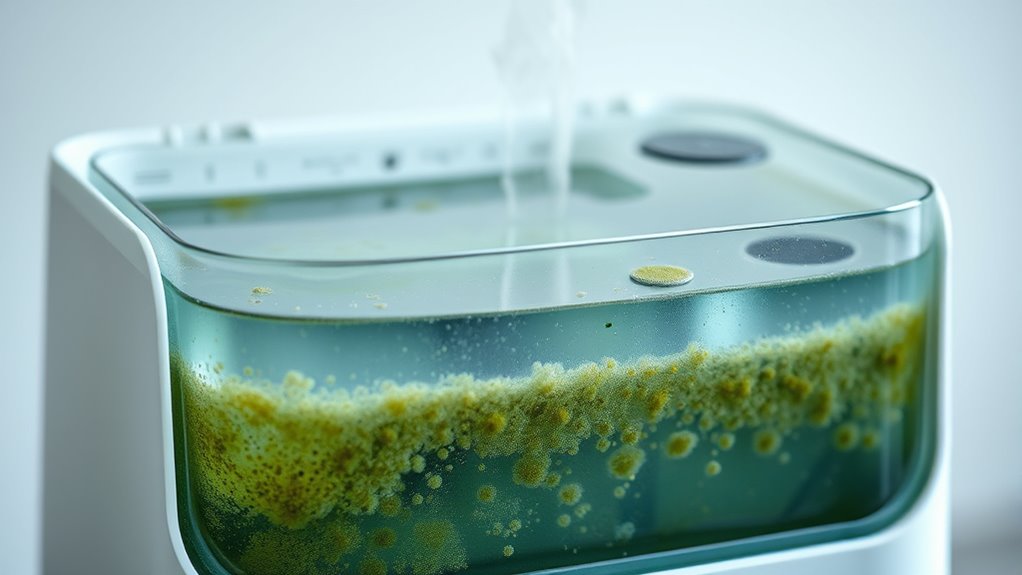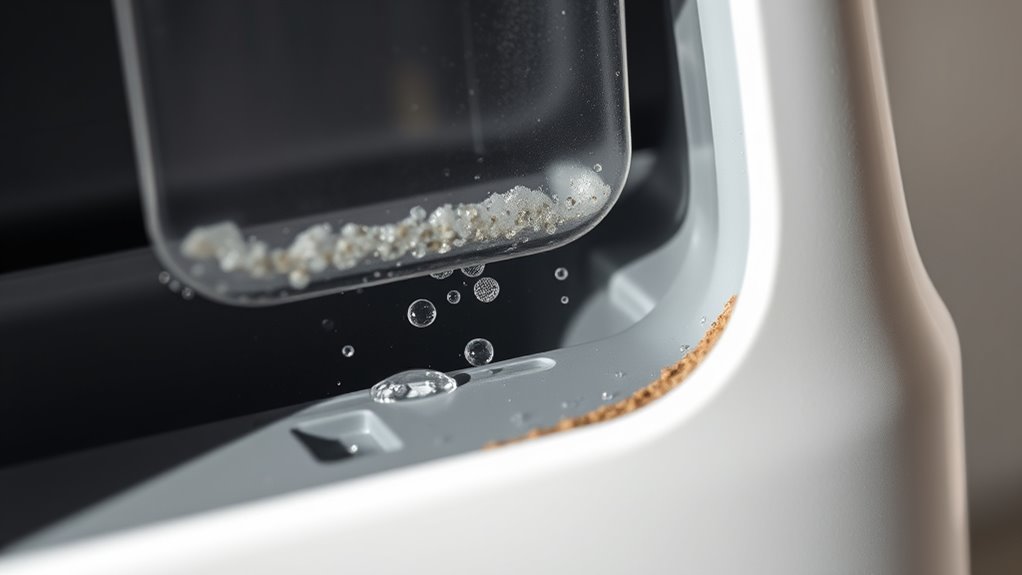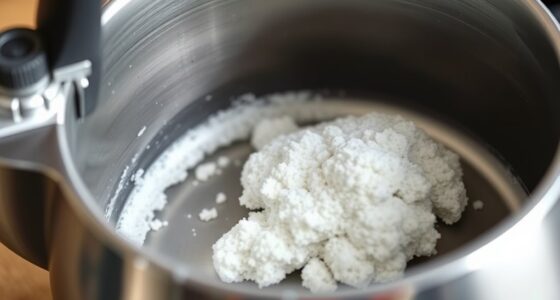To stop the ‘dirty tank’ problem, you should clean your humidifier regularly—ideally once a week—and always after daily use. Unplug the device, discard leftover water, and scrub the tank with a vinegar solution to dissolve mineral buildup and kill mold spores. Rinse thoroughly and dry all parts before reassembling. Proper maintenance prevents microbial growth, keeps your indoor air clean, and prolongs your humidifier’s life. Keep going to discover more simple tips for healthy, safe humidity.
Key Takeaways
- Empty and discard water daily to prevent microbial growth and mineral buildup.
- Clean the tank weekly with vinegar solution to dissolve deposits and eliminate mold spores.
- Use a soft brush to scrub corners and crevices, ensuring thorough removal of residue.
- Dry all parts completely before reassembling to prevent mold and bacteria development.
- Regularly replace or clean filters as per manufacturer instructions for optimal hygiene.

Keeping your humidifier clean is vital to prevent the buildup of mold, bacteria, and mineral deposits that can affect your health. When you neglect regular cleaning, these harmful agents can thrive inside the tank and spread into the air you breathe. This can lead to respiratory issues, allergies, or even infections, especially if you or your family members have compromised immune systems. To keep your humidifier operating safely and efficiently, establishing a routine cleaning schedule is essential. You should aim to clean the tank at least once a week, or more often if you use it daily. Regular maintenance not only extends the lifespan of your device but also guarantees that the moisture it releases is clean and safe.
Regularly cleaning your humidifier prevents mold, bacteria, and mineral buildup, ensuring safe, healthy moisture for your home.
Start by unplugging your humidifier before cleaning. Empty out any remaining water and discard it properly. Bacteria and mold love standing water, so leaving water sitting in the tank creates an ideal environment for growth. Once emptied, rinse the tank with clean water to remove loose deposits. Use a soft brush or cloth to scrub away any visible buildup, paying close attention to corners and crevices where residue tends to accumulate. For stubborn mineral deposits and mold, a mixture of white vinegar and water works wonders. Fill the tank with a solution of half vinegar, half water, and let it sit for 20-30 minutes. The acidity of vinegar dissolves mineral buildup and kills mold spores. After soaking, scrub gently and rinse thoroughly to eliminate any vinegar smell or residue. Proper cleaning is essential to prevent harmful microbes from thriving in your device.
Avoid using harsh chemicals or abrasive tools, as they can damage the tank and potentially release harmful substances into the air. Dry all parts thoroughly before reassembling to prevent mold growth. If your humidifier has a filter, check the manufacturer’s instructions on cleaning or replacing it. Some filters need to be replaced regularly, while others can be cleaned with vinegar or mild soap. Properly maintained filters improve air quality and prevent contaminants from circulating.
In addition to weekly cleanings, it’s wise to change the water daily if you use your humidifier frequently. Stale water promotes bacterial growth, and fresh water ensures cleaner humidity. Keep the tank in a dry, well-ventilated area when not in use to reduce moisture buildup and prevent mold from taking hold. Regular cleaning and proper maintenance aren’t just about keeping your device functioning—they’re about safeguarding your health. A clean humidifier provides you with humidified air free of mold, bacteria, and mineral deposits, helping you breathe easier and stay healthier.
Frequently Asked Questions
How Often Should I Replace My Humidifier’s Filter?
You should replace your humidifier’s filter every 1 to 3 months, depending on usage and water quality. Regularly check for signs of dirt, mold, or reduced performance, and replace it more often if needed. Using clean, filtered water and keeping the humidifier sanitized helps extend the filter’s lifespan. Don’t forget to follow the manufacturer’s recommendations for your specific model to guarantee superior humidity and air quality.
Can I Use Vinegar to Clean My Humidifier?
Yes, you can use vinegar to clean your humidifier. Fill the tank with a mixture of equal parts white vinegar and water, then let it sit for about 30 minutes. This helps dissolve mineral deposits and bacteria buildup. After soaking, scrub any remaining residue with a soft brush, rinse thoroughly, and let it dry completely before using again. Regular vinegar cleaning keeps your humidifier hygienic and safe.
Are There Natural Alternatives to Chemical Disinfectants?
Think of natural alternatives as gentle guardians for your humidifier. You can use hydrogen peroxide, which acts like a silent sentinel, or a mixture of white vinegar and water to banish bacteria. Baking soda also helps scrub away grime without harsh chemicals. These options keep your tank fresh and safe, like a breath of clean air, ensuring your humidifier works efficiently without introducing unwanted chemicals into your space.
What Signs Indicate My Humidifier Needs Professional Cleaning?
You should get your humidifier professionally cleaned if you notice persistent mold or slimy buildup inside the tank, a foul odor that won’t go away, or if it’s producing cloudy or discolored mist. If you experience unexplained allergies, respiratory issues, or your humidifier isn’t functioning properly despite regular cleaning, it’s time to seek expert help. Regular inspections help prevent bacteria and mold growth, ensuring safe, healthy moisture in your environment.
How Does Water Quality Affect Humidifier Hygiene?
Poor water quality can turn your humidifier into a breeding ground for mold and bacteria. When you use hard or contaminated water, mineral deposits and germs accumulate faster, making it harder to keep the tank clean. This risks spreading germs into the air you breathe. To prevent this, always use distilled or filtered water, clean your humidifier regularly, and avoid letting water sit for long periods.
Conclusion
Keeping your humidifier clean isn’t just about avoiding unpleasant odors — it’s about protecting your health. Regularly cleaning the tank prevents mold, bacteria, and algae from thriving. Don’t let a dirty tank turn your comfort into a health risk. Isn’t it worth a few minutes of maintenance to breathe easier? Stay proactive, clean your humidifier often, and enjoy pure, safe moisture all season long. Your lungs will thank you!









